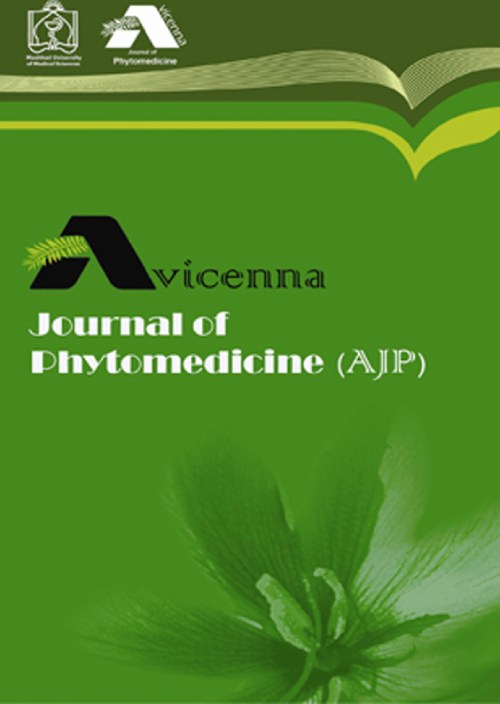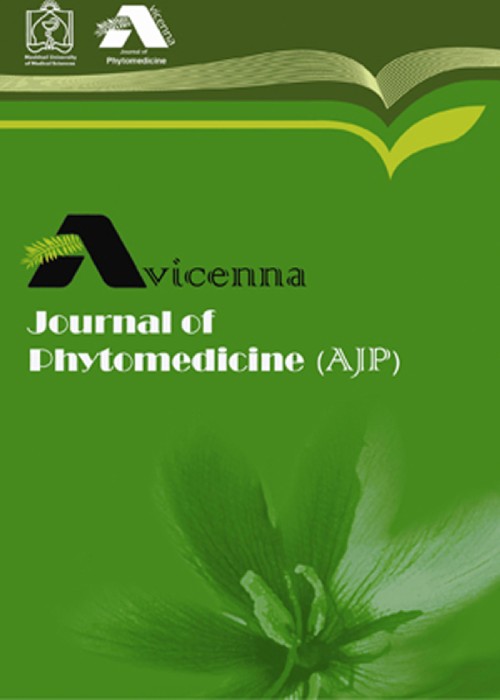فهرست مطالب

Avicenna Journal of Phytomedicine
Volume:13 Issue: 1, Jan-Feb 2023
- تاریخ انتشار: 1401/10/04
- تعداد عناوین: 10
-
-
Pages 7-17Objective
Cyclophosphamide (CP)-induced testicular toxicity has been reported in recipient patients. The current study was designed to evaluate protective effects of hydroalcoholic extract of Rosa canina L. fruit (HARF) against CP-induced testicular toxicity in BALB/c mice.
Materials and MethodsThirty-five mice were divided into five groups as follows: group I (control), group II (CP, received CP 100 mg/kg on days 1, 8, 15, and 22), group III (CP + HARF 250 mg/kg), group IV (CP + HARF 500 mg/kg), and group V (CP + HARF 750 mg/kg). In the groups III, IV, and V that received CP, the HARF was simultaneously administered via intraperitoneal injections for 28 consecutive days starting from day 1. On the 29th day, sperm parameters, stress oxidative biomarkers, and mRNA expression of nuclear factor erythroid-derived-2 (Nrf2) in testis tissue, as well as blood testosterone were evaluated.
ResultsThe CP exposure decreased sperm parameters, superoxide dismutase (SOD) activity, testosterone, and Nrf2 mRNA expression levels and increased the malondialdehyde (MDA). HARF at the dose of 500 mg/kg improved sperm count and viability and increased SOD and catalase activities, glutathione peroxidase (GPx) activity, testosterone level, and Nrf2 expression and reduced MDA. Also, HARF at the dose of 750 mg/kg improved sperm parameters and increased SOD, catalase, and GPx activities, total testosterone level, and Nrf2 expression, and reduced MDA in comparison with the CP group.
ConclusionAccording to our findings, HARF at the doses of 500 and 750 mg/kg inhibited the ruinous effects of CP on the reproductive system in mice.
Keywords: Rosa canina L, Cyclophosphamide, Oxidative stress, Nuclear factor erythroid-derived-2, Sperm, Testosterone -
Pages 18-33Objective
Based on the results of previous studies, the effects of N. sativa on some of the non-alcoholic fatty liver disease's (NAFLD) biomarkers were positive; however, there were conflicting results regarding other variables. Therefore, the present systematic review of clinical trials was designed to clarify whether N. sativa effectively prevents the progression of NAFLD.
Materials and MethodsA search of four databases (Scopus, PubMed, Medline, and Google scholar) was conducted to identify the clinical trials that assessed the effects of N. sativa supplementation on NAFLD. The outcome variables of interest were biomarkers of hepatic steatosis, liver enzymes, insulin resistance, and inflammation.
ResultsOverall, four randomized clinical trials (RCTs) were included. In three studies, hepatic steatosis grade decreased significantly after N. sativa supplementation. Serum levels of liver enzymes reduced significantly in three of four included trials. In the only study that examined the effect of N. sativa on insulin resistance parameters, all variables related to this factor were significantly reduced. In two included studies that measured biomarkers of inflammation, the serum levels of tumor necrosis factor α (TNF-α), high-sensitive C-reactive protein (hs-CRP), and interleukin 6 (IL-6) decreased significantly after intaking N. sativa supplements.
ConclusionAlthough the efficacy of N. sativa on liver enzymes and the grade of hepatic steatosis was reported in some of the included studies, more well-designed clinical trials are needed to determine the definitive effects of N. sativa on NAFLD. The present study provides suggestions that help to design future studies in this field.
Keywords: Nigella Sativa, Non-alcoholic fatty liver disease, Clinical Trials, Systematic review -
Pages 34-44ObjectiveMedicinal plants with fewer side effects and low cost than synthetic medicines are increasingly advised to treat diseases. The present study aimed to identify Eryngium billardieri compounds and evaluate the plant’s effects on hyperglycemic and hyperlipidemia indices, and liver, and kidney function.Materials and MethodsFollowing identification of Eryngium billardieri using GC/MS method, 72 participants were randomly divided into two groups (n=36 per group), receiving oral hypoglycemic medication (metformin) with or without 50 ml hydrosol twice a day for three months as intervention and placebo control, respectively. Body mass index (BMI), systolic and diastolic blood pressure, fasting blood sugar (FBS), glycosylated hemoglobin (HbA1c), total cholesterol, triglyceride, HDL-C, and LDL-C levels were measured at the beginning and end of the experiment. Also, aspartate transaminase, alanine transaminase, blood urea nitrogen, and creatinine levels were measured to assess adverse effects on liver and kidney functions.ResultsThe main components were terpenes with 46.69% of the total ingredients of E. billardieri essential oil. Other prominent compounds identified included octanoic acid (12.14 %) and isoxazole (6.72 %). Intergroup changes in blood parameters showed that E. billardieri hydrosol for three months could significantly reduce HbA1C and blood cholesterol levels but did not affect other measured parameters. Also, there were no adverse effects on kidney or liver function.ConclusionThe present findings showed that the consumption of 50 ml of E. billardieri hydrosol as a complementary treatment in diabetic patients reduced HbA1C and cholesterol levels without adverse effects on the liver or kidneys functions.Keywords: Antidiabetic activity, Blood lipid profile, Glycemic Index, Glycosylated hemoglobin, Medicinal plant
-
Pages 45-57ObjectiveMigraine is one of the most common diseases. Curcumin with anti-oxidative and anti-neuroinflammatory properties might have beneficial effects in migraine patients. This study will be conducted to evaluate the effects of a phytosomal preparation of curcumin on clinical signs, oxidative stress, and inflammatory parameters in patients with migraine.Materials and MethodsThis is a randomized, double-blind, placebo-controlled, clinical trial in which, 60 patients with migraine will be assigned to receive a daily dose of 250 mg of phytosomal curcumin for 8 weeks (intervention group) or 250 mg maltodextrin as a placebo for the same duration (control group). Before and after the study, frequency, duration, and severity of the attacks, quality of life and sleep, mood status, high-sensitivity C-reactive protein (hs-CRP), Nitric Oxide (NO), and oxidative stress factors will be measured.ConclusionIt seems that phytosomal formulation of curcumin (a solid dispersion preparation of curcumin with phosphatidylserine) with high bioavailability, can cross the blood-brain barrier (BBB) and result in decreased neuroinflammation, oxidative stress, and neurotoxicity. This way, phytosomal curcumin might lead to reduction of headaches and other complications of migraine and increase the quality of life of patients with migraine.Keywords: Curcumin, Phytosomal curcumin, Migraine, Inflammation, Headache
-
Pages 58-69ObjectiveCigarette smoke (CS) contains compounds such as reactive oxygen species (ROS). Oxidative stress caused by excessive ROS eventually leads to germ cell apoptosis and male infertility. The leaves of Cichorium intybus (chicory) are rich in natural antioxidants, but their protective effects on the adverse effects of CS on testicular tissue have not been studied.Materials and Methods24 Wistar rats were classified into four groups: control, extract: treatment with chicory extract (200 mg/kg body weight/day) for 13 weeks, smoke: exposed to CS for 13 weeks, and smoke + extract: exposed to CS and treated with the C. intybus extract. Histological and biochemical analyses and apoptosis assay were done, and Ahr, and Cyp1a1 expression was determined.ResultsTreatment with C. intybus compensated for the reduction of Sertoli cells, spermatogonia, spermatocytes, and spermatids caused by CS. Chicory extract reduced free radicals and improved antioxidant status. The lowest and highest percentage of apoptotic cells was observed in the extract and smoke groups, respectively, while simultaneous treatment with C. intybus extract led to a significant reduction of apoptotic cells. The mean Ahr levels in the control, extract, smoke and smoke + extract groups were 1.00±0.57, 1.93±0.25, 5.98±0.42, and 0.62±0.22, respectively (p˂0.05). The mean levels of Cyp1a1 expression in the control, extract, smoke and smoke + extract groups were 1.00±0.31, 2.28±0.65, 5.55±0.40, and 0.21±0.23 (p˂0.05).ConclusionThe C. intybus extract probably affected Cyp1a1 expression by downregulation of Ahr. These led to a decrease in free radicals and apoptosis, and an improvement in antioxidant status.Keywords: Cichorium Intybus, Spermatogenesis, Malondialdehyde, Caspase-3, Cigarette smoke
-
Pages 70-84ObjectiveThe present study examined the effects of Artemisia absinthium L. on scopolamine-induced memory dysfunction and brain tissue oxidative damage in rats.Materials and MethodsFifty rats were used in five groups: Control: received dimethyl sulfoxide (DMSO)/saline, Scopolamine: scopolamine (2 mg/kg) was administered along with DMSO/saline, and Scopolamine-Ext 50, Scopolamine-Ext 100, and Scopolamine-Ext 200 groups: A. absinthium hydroalcoholic extract 50, 100 and 200 mg/kg were administered before scopolamine. The Morris water maze (MWM) and passive avoidance (PA) tasks were used for assessment of behavioral parameters. Malondialdehyde (MDA), nitric oxide (NO) metabolites, total thiol, catalase (CAT), and superoxide dismutase (SOD) were measured in the cortex and hippocampus.ResultsA. absinthium decreased the delay time and distance traveled to reach the platform in the MWM test (p<0.05-p<0.001). Besides, the extract increased the delay time to pass in the dark and the light time while decreasing the number of entrances and the dark time in the PA task (p<0.05-p<0.001). In biochemical assessments, A. absinthium attenuated NO metabolites (p<0.001) and MDA (p<0.05- p<0.001) while enhanced total thiol (p<0.001), CAT and SOD (both p<0.05-p<0.001).ConclusionThis study revealed that A. absinthium improved memory and learning impairment and brain tissue oxidative damage in scopolamine-treated rats.Keywords: Artemisia absinthium, Memory, Oxidative stress, Scopolamine
-
Pages 85-96ObjectivePortulaca oleracea, commonly known as Purslane, is traditionally used as a sour, diuretic, and cooling herb with hemostatic properties. The present study evaluates the antianemic effect of methanolic and aqueous extracts of P. oleracea in a phenylhydrazine model of anemia.Materials and MethodsPhenylhydrazine (60 mg/kg/day, i.p., two consecutive days) was used to induce anemia in rats. The aqueous and methanolic extracts of P. oleracea were prepared, and three methods of treatment were defined with two doses (500 and 750 mg/kg, i.p.). The hematological parameters and blood cell morphology, total and direct bilirubin, and morphology, and pathology of bone marrow were evaluated.ResultsThe results showed that the methanolic extract has better effects than aqueous extract in improving phenylhydrazine-induced anemia. Our results showed that administration of 500 and 750 mg/kg of P. oleracea methanolic extracts for 4 days could protect against the development of anemia caused by phenylhydrazine.ConclusionIn summary, the methanolic extracts of P. oleracea might be effective in phenylhydrazine-induced anemia.Keywords: Purslane, Phenylhydrazine, Anemia, Methanolic extract, Aqueous extract
-
Pages 97-108ObjectiveThrombin is a proinflammatory and pro-coagulant agent which is upregulated in several human diseases. Thrombin has a critical role in promoting cell proliferation and microvascular leakage in malignant cells, resulting in cancer growth and progression. Here, we explored the potential therapeutic value of curcumin on permeability induced by thrombin in mice.Materials and MethodsTo assess the activity of curcumin on thrombin-induced vascular permeability mice model, C57BL / 6 mice were randomly divided into four groups: (1) control (2) Thrombin (3) Thrombin + Curcumin and (4) Thrombin + Metformin. Thirty minutes after treatment, Evans blue was injected intravenously through the tail vein to mice. Then, animals were sacrificed and the dye was extracted from the skin tissue by incubation with formamide. Heatmap and correlation map were generated and protein-protein interaction network of the hub genes was drawn by Cytoscape software.ResultsHub DEG expression rate showed that Heat shock protein a1 (Hspa1) family (comprised of HSPa1a, b, and HSPa5), caspase 3, and minichromosome maintenance complex component 2 were overexpressed after treatment with curcumin. Functional modules of curcumin enriched through Enrich gene biological process and revealed positive association of gene expression of apoptosis process with the therapy. Curcumin was also found to reduce leucocyte migration in murine tissues. Additionally, treatment with curcumin resulted in downregulation of heat shock proteins and proinflammatory cytokines such as monocyte chemotactic protein 1, interleukin-6 and chemokine (C-X-C motif) ligand 3.ConclusionCurcumin inhibited the proinflammatory cytokines and inflammatory HSPs in endothelial cells and reduced thrombin-induced barrier destabilization in vivo.Keywords: Thrombin, Curcumin, Vascular permeability


